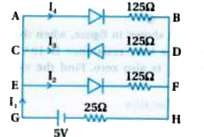The number density of electron is 4.5×1022m−3 and number density of holes is 4.5×109m−3. This semiconductor is ……….. Solution in Gujrati
p-type
n-type
intrinsic type
p and n both type
The correct Answer is:B
n-type
Here ne=4.5×1022m−3andnh=4.5×109m−3
∴ne>nh therefore n-type semiconductor.
Topper's Solved these Questions
- SEMICONDUCTOR ELECTRONICS : MATERIALS, DEVICES AND SIMPLE CIRCUITS BOOK - KUMAR PRAKASHANCHAPTER - SEMICONDUCTOR ELECTRONICS : MATERIALS, DEVICES AND SIMPLE CIRCUITS EXERCISE - Section-D : Multiple Choice Questions (MCQs) (MCQs asked in Competitive Exams)
129 Videos
- SEMICONDUCTOR ELECTRONICS : MATERIALS, DEVICES AND SIMPLE CIRCUITS BOOK - KUMAR PRAKASHANCHAPTER - SEMICONDUCTOR ELECTRONICS : MATERIALS, DEVICES AND SIMPLE CIRCUITS EXERCISE - Section-C: NCERT Exemplar Solution (Long Answer Type Questions)
10 Videos
- SAMPLE QUESTION PAPER BOOK - KUMAR PRAKASHANCHAPTER - SAMPLE QUESTION PAPER EXERCISE - PART-B SECTION-C
5 Videos
- WAVE OPTICSBOOK - KUMAR PRAKASHANCHAPTER - WAVE OPTICSEXERCISE - SECTION-D (MULTIPLCE CHOICE QUESTIONS (MCQS)) (MCQS FROM DARPAN BASED ON TEXTBOOK)
239 Videos
Similar Questions
At absolute zero temperature Si acts as ……..
View Solution
If each diode in figure has a forward bias resistance of 25Ω and infinite resistance in reverse bias, what will be the values of the current I1,I2,I3andI4?
View SolutionTwo charges –q and +q are located at points (0, 0, –a) and (0, 0, a), respectively.
(a) What is the electrostatic potential at the points (0, 0, z) and (x, y, 0) ?
(b) Obtain the dependence of potential on the distance r of a point from the origin when r/a>>1 .
(c) How much work is done in moving a small test charge from the point (5,0,0) to (–7,0,0) along the x-axis? Does the answer change if the path of the test charge between the same points is not along the x-axis?
View SolutionAccording to particle theory of light what is the velocity of light in a dense medium, compared to that in rare medium ?
View SolutionA pure semiconductor has equal electron and hole concentration of 10^(6)m^(-3) . Dopping by indium increases n_(h) to 4.5xx10^(22)m^(0k3) . What is n_(e) in the dopped semiconductor?
View SolutionPure Si at 500K has equal number of electron (ne) and hole (nh) concentration of 1.5×1016m−3. Dopping by indium. Increases nh to 4.5×1022m−3. The doped semiconductor is of
View SolutionThe number density of free electrons in the semiconductor is 1018m−3. It is doped with a pentavalent impurity atoms of number density 1024m−3, the number density of free electrons m−3 increases by a factor of
View SolutionThe density of an electron-hole pair in a pure germanium is 3×1016m−3 at room temperature. On doping with aluminium, the hole density increases to 4.5×1022m−3. Now the electron density ( in m−3) in doped germanium will be
View SolutionIn an intrinsic semiconductor, the density of conduction electrons is 7.07×1015m−3 . When it is doped with indium, the density of holes becomes 5×1022m−3. Find the density of conduction electron is doped semiconductor
View Solutionएक अर्द्धचालक का इलेक्ट्रॉन घनत्व 8×1014/सेमी3 तथा होल घनत्व 5×1012सेमी3 है। अर्द्धचालक है
View SolutionThe density of an electron - hole pair in a pure germanium is 3xx10^(-16) m^(-3) at room temperature. On doping with aluminium , the hole density increase to 4.5xx10^(22) m^(-3) Now the electron density ( in m ) in doped germanium will be
View SolutionThe number density of free electrons in the semiconductor is 10^(18) m^(-3) . It is doped with a pentavalent impurity atoms of number density 10^(24) m^(-3) . The number density of free electrons m^(-3) increases by a factor of
View SolutionAt temperature 300 K number density of electrons and holes in pure silicon is 1.5xx10^(16)m^(-3) . The number density of hole increase by 4.5xx10^(22)m^(-3) dopping the indium impurity so calculate number denstiy of electron.
View SolutionThe number density of electron is 7×1012m−3 and number density of hole is 7×1012m−3. This semiconductor will be ….. Type.
View SolutionPure Si at 500 K has equal number of electron (n_(e )) and hole (n_(h)) concentrations of 1.5xx10^(16)m^(-3) . Doping by indium increases n_(h) to 4.5xx10^(22)m^(-3) . The doped semiconductor is of ………
View Solution
